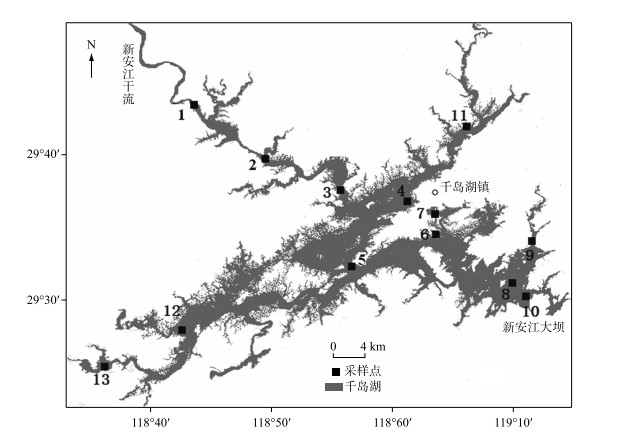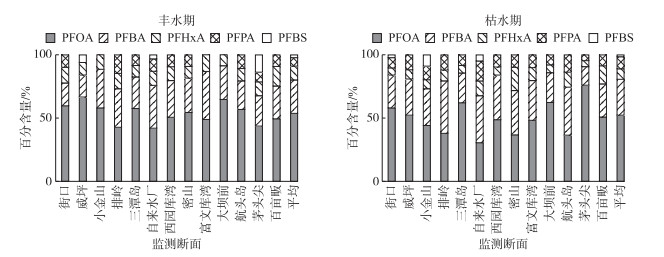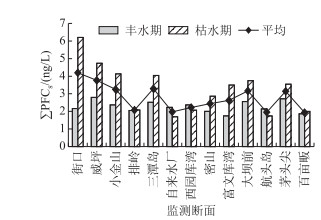(2: 淳安县环境保护监测站, 杭州 311700)
(2: Chunan Environmental Monitoring Station, Hangzhou 311700, P. R. China)
全氟化合物(perfluorinated compounds,PFCs)为一类人造材料,自问世以来大量应用于防水织物、纸张、乳化剂以及日常消费品、清洗溶液等领域[1-2].由于PFCs在环境中难降解,可远距离传输,并能通过食物链在动物和人体中累积、放大,造成该类化合物在全球范围内的广泛污染,各种环境介质中均有其残留检出[3-4].研究表明,该类物质具有致畸、致癌及神经毒性等多种毒性效应,并具有内分泌干扰特性,《斯德哥尔摩公约》已于2009年5月将PFCs中的全氟辛烷磺酸(perfluorooctanesulfonate,PFOS)及其盐增列入POPs禁用名单[5],PFCs对人体健康的潜在危害引起了全球范围的广泛关注[6-7].近年来,随着我国经济社会的快速发展,许多行业大量使用全氟表面活性剂,PFCs的环境污染问题同样日趋严重[8-9].
大部分PFCs具有较强表面活性,且具有蒸汽压低、水溶性高等特点,易于在各种水体中累积.水体环境既是PFCs的汇,也是重要污染源[3],因此了解PFCs在水环境中的分布特征就显得尤为重要.杭州地处我国氟化工产业发达地区,区域水环境PFCs污染不可避免,朴海涛等[10]对京杭大运河水体中PFCs污染调查发现杭州段4个采样点ΣPFCs浓度均值为126.4 ng/L,是整个运河水系中污染最高的河段,而我们前期的研究[11]也发现钱塘江(杭州段)水体中存在明显的PFCs污染,各监测断面表层水ΣPFCs浓度在0.98~609 ng/L之间(均值176 ng/L).千岛湖属钱塘江流域新安江水系,是我国最大的人工湖泊之一,其巨大的水资源量对当地及长江三角洲的经济和社会发展具有重大影响,随着杭州市第二水源千岛湖配水工程的启动,作为未来杭州市主城区的饮用水源,其水环境质量更是受到社会各界的广泛关注.目前,针对千岛湖地区水环境的研究已比较多,其中水质变化方面的研究以水常规指标和生物指标为主[12-16].近年来,千岛湖多环芳烃[17]、有机氯农药[18-19]等持久性有机物污染研究工作正逐步开展,但涉及PFCs的尚属空白.基于此,本研究对千岛湖水体中的16种PFCs进行了测定,探讨其时空分布特征,评价其污染现状,并解析其污染来源,以期为千岛湖及同类水体今后的水环境保护积累重要的基础资料及提供可信的理论依据.
1 材料与方法 1.1 标准样品与试剂16种PFCs混合标准溶液系列(美国Waters公司,500 mg/L,186004624),包含:全氟丁酸(perfluorobutyric acid, PFBA)、全氟戊酸(perfluoropentanoic acid, PFPA)、全氟己酸(perfluorohexanoic acid,PFHxA)、全氟庚酸(perfluoroheptanoic acid,PFHpA)、全氟辛酸(perfluorooctanoic acid,PFOA)、全氟壬酸(perfluorononanoic acid,PFNA)、全氟癸酸(perfluorodecanoic acid,PFDA)、全氟十一烷酸(perfluoroundecanoic acid,PFUnDA)、全氟十二烷酸(perfluorododecanoic acid,PFDoDA)、全氟十三烷酸(perfluorotridecanoic acid,PFTrDA)、全氟十四烷酸(perfluorotetradecanoic acid,PFTeDA)、全氟丁基磺酸(perfluorobutanesulphonic acid,PFBS)、全氟己基磺酸钾(perfluorohexanesulfonic acid,PFHxS)、全氟庚基磺酸(perfluoroheptanesulfonic acid,PFHpS)、全氟辛烷磺酸(perfluorooctanesulfonic acid,PFOS)、全氟葵基磺酸(perfluorodecanesulfonic acid,PFDS).甲醇(色谱纯,德国Merck公司),乙酸铵(99 %)(色谱纯,美国Tedia公司),实验用水为Milli-Q纯净水.
1.2 样品采集与处理分别于千岛湖枯水期(2017年1月)和丰水期(2017年7月)进行现场采样,选取千岛湖水域有代表性的区域及其3条主要入湖河流共13个采样点(图 1),各采样点位详细情况见表 1.每个样点以有机玻璃采样器采集表层水(水面以下0.5 m)2 L,混匀后装入聚丙烯广口瓶.带回实验室的地表水样品立刻经0.7 μm玻璃纤维滤膜去除颗粒物质.取500 mL样品过Waters WAX固相萃取柱(柱子分别用5 mL甲醇,5 mL 1 %氨水甲醇溶液,5 mL去离子水预处理),然后用5 mL 20 %甲醇淋洗,最后依次用4 mL甲醇、4 ml 1 %氨水甲醇溶液洗脱.洗脱液氮吹浓缩至干,残留物用1 mL 50 %甲醇水溶液溶解后,过0.2 μm GHP微孔滤膜,待UPLC-ESI-MS/MS分析.若水样不能即时处理,则0.7 μm玻璃纤维滤膜过滤后置于聚丙烯瓶中冷冻保存,检测前解冻放至室温再经SPE处理.

|
图 1 千岛湖采样点分布 Fig.1 Distribution of sampling sites in Lake Qiandao |
| 表 1 千岛湖采样点位置 Tab. 1 Distribution of sampling sites in Lake Qiandao |
采用超高效液相色谱仪-串联三重四极杆质谱仪(Waters UPLC-Xevo TQMS)测定水样中PFCs浓度,具体参照文献[20];色谱柱为Waters ACQUITY UPLCTM BEH C18柱(50 mm×2.1 mm,1.7 μm);流动相分别为2 mmol/L乙酸铵水溶液(流动相A)和2 mmol/L乙酸铵甲醇(流动相B),梯度洗脱,洗脱程序为:0~0.5 min,25 % B;0.5~4.5 min,25 % ~55 % B;4.5~5.0 min,55 % ~95 % B;5.0~6.0 min,95 % B;6.0~6.5 min,95 % ~25 % B.流速0.4 mL/min;柱温40℃;样品室温度10℃;进样体积5.0 μL.采用电喷雾电离源(ESI)负离子扫描,多反应监测(MRM)模式检测;毛细管电压为3.0 kV;离子源温度为150℃; 脱溶剂温度500℃;脱溶剂气流量(氮气)和锥孔气流量(氮气)分别为800、30 L/h;碰撞气流量(氩气)为0.15 mL/min.
1.4 质量控制与保证本次研究水样检测用的液质联用仪采用的色谱管路为全peek塑料管路,且整个实验过程避免使用聚四氟乙烯材质的器皿,防止引入高背景值.为控制样品前处理过程可能带来的外源性污染,样品检测的同时以超纯水作为空白基质完成方法空白,方法空白除了PFOA(浓度约为0.1 ng/L)有检出外,其余待测PFCs均未检出.所有实验结果均为扣除空白基质后的数据. 16种PFCs的加标回收率在67.6 % ~109 %之间,相对标准偏差范围为2.9 % ~12 %,符合美国EPA的要求(回收率范围100 % ±40 %). 16种PFCs在1.0~100 μg/L范围的线性相关系数(r)为0.9987~0.9999,检测限在0.06~0.48 ng/L之间,满足分析要求.
1.5 统计分析本研究中,样品低于检出限的质量浓度计为0,数据分析使用SPSS 13.0软件(SPSS Inc.,2005),使用Pearson相关系数分析样品中各种PFCs浓度的相关性.
2 结果与讨论 2.1 千岛湖水体中PFCs污染水平对千岛湖13个监测断面枯水期、丰水期的表层水样品中16种PFCs浓度进行分析,所有水样中共检出5种PFCs,包括1种全氟烷基磺酸(perfluorosulphonic acids,PFSAs)以及C4、C5、C6和C8 4种全氟烷基羧酸(perfluorocarboxylic acids,PFCAs),详细结果见表 2.千岛湖枯水期样品中ΣPFCs浓度范围为1.70~6.21 ng/L,丰水期则为1.75~2.80 ng/L. 5种PFCs的检出率呈PFOA=PFBA=PFHxA(100 %)>PFPA(85 %)>PFBS(23 %)的顺序.按照碳链长短把PFCs分为3类,即短链(C≤6)、中链(7≤C≤10)和长链(C≥11),本次千岛湖水体中检出的PFCs全部为中短链的化合物,而长链的化合物均未在样品中检测到,主要污染物为PFOA和PFBA,这说明中短链的全氟产品在千岛湖流域内的生产和使用量多于长链,也有可能是由于溶水性的长链PFCs更倾向于分配到沉积物和悬浮颗粒物中[21],分配到水相的浓度较低而未检出.千岛湖表层水中PFCs的百分含量组成如图 2所示,丰水期各PFCs单体的平均百分含量由大至小依次为PFOA(54.0 %)>PFBA(26.3 %)>PFHxA(11.0 %)>PFPA(6.60 %)>PFBS(2.07 %),而枯水期则是PFOA(52.4 %)>PFBA(28.3 %)>PFPA(9.58 %)>PFHxA(8.37 %)>PFBS(1.39 %),丰水期、枯水期两批次样品检出的PFCs百分组成整体上相近,均以PFOA为主.现有文献报道表明区域工业生产中使用的物质不同,会导致不同地区的地表水中PFCs单体的浓度有所差异,如So等[22]研究发现长江流域水体中PFOA对总全氟化合物的贡献率则达到48.1 % ~98.0 %,而珠江流域水体中PFOA的贡献率相对较小(4.4 % ~26.7 %),我们前期的研究结果显示钱塘江(杭州段)表层水中PFOA的贡献率在33.0 % ~93.2 % [11].本次研究中,千岛湖水样中PFOA占ΣPFCs的30.6 % ~76.1 %,略低于钱塘江(杭州段)表层水. PFOA检出浓度除了在枯水期的排岭、自来水厂和航头岛3个断面水样中污染占比低于PFBA外,其余样品中均高于其他检出PFCs,显示PFOA为千岛湖表层水中PFCs的主要污染物.
| 表 2 千岛湖表层水体中PFCs检出率和残留水平(ng/L)* Tab. 2 Detection rate and residue levels of PFCs in the surface water from Lake Qiandao |

|
图 2 千岛湖表层水中5种PFCs的百分组成 Fig.2 Percentage compositions of 5 PFCs species in surface water samples from Lake Qiandao |
本研究中,千岛湖表层水中PFOA浓度范围为0.52~3.61 ng/L,均值1.47 ng/L,PFOS则低于检出限(0.10 ng/L).我国目前尚未颁布关于PFCs的地表水环境质量标准,有学者基于我国本土生物物种的毒性数据,利用欧盟化学物质风险评价技术指导文件中计算预测无效应浓度(PNEC)的方法,提出水体中PFOA[23]和PFOS[24]的PNEC值分别为0.57 mg/L和1 μg/L,千岛湖所有水样中PFOA和PFOS浓度水平均远低于文献建议的PNEC值.与表 3中国内外其它淡水湖库等类似水体相比[25-35]:千岛湖PFOA浓度与官厅水库、鄱阳湖的污染水平相当,比深圳水库群和意大利Lake Maggiore略低,低于太湖、武汉东湖、东莞同沙水库、巢湖和韩国Lake Shihwa,更是远低于作为武汉城区典型纳污湖的汤逊湖,属低污染水平;PFOS在千岛湖表层水中未见检出,污染水平低于官厅水库和鄱阳湖,更是明显低于表 3所列的其他淡水湖库水体.水环境中PFCs污染水平与人类生活和区域工业化程度密切相关,千岛湖表层水较低的浓度水平可能归因于区域较低的工业发展水平和较低的人口密度,当然也得益于当地政府为保护千岛湖生态环境而长期实施的各项严格的环境保护措施.
| 表 3 文献报道淡水湖库水体中PFOA和PFOS浓度比较1) Tab. 3 Comparison of PFOA and PFOS concentrations in water samples from freshwater lake in previous studies |
研究区域各监测断面水体中ΣPFCs浓度分布情况如图 3所示.对比千岛湖丰水期和枯水期水样中ΣPFCs浓度可知,13个监测断面中,除了自来水厂、西园库湾、航头岛和排岭等4个断面水样中检出ΣPFCs浓度是丰水期高于枯水期外,其余各监测断面ΣPFCs浓度均是枯水期高于丰水期.对各监测断面在不同采样期的ΣPFCs浓度进行配对t检验,发现丰水期和枯水期季节性差异显著(P < 0.05),枯水期各监测断面水体中ΣPFCs平均值为3.26 ng/L,是丰水期(平均值2.27 ng/L)的1.4倍,主要原因可能为雨季湖水的稀释作用,整体上呈点源污染特征.另外,枯水期各监测断面检出ΣPFCs浓度差异较大,而丰水期则基本处于同一浓度水平,差异较小.分析千岛湖各采样断面不同时期ΣPFCs浓度平均值的空间分布特征(图 3),发现区域水体PFCs污染整体上西北湖区较高,东北、西南及中心湖区较低,随着湖水流向到出境的东南湖区又略有升高,其中最高点是街口断面,两期水样ΣPFCs平均值为4.18 ng/L,其次是其下游同样位于新安江干流的威坪断面(3.77 ng/L).从各PFCs单体来看,PFOA、PFBA、PFPA浓度均值最高点都位于街口,PFHxA于密山检出最高值,PFBS则是小金山和茅头尖.

|
图 3 千岛湖表层水中ΣPFCs浓度的分布特征 Fig.3 Spatial distribution of ΣPFCs concentration in surface water of Lake Qiandao |
对千岛湖不同监测断面表层水中检出的5种PFCs单体浓度相关关系进行分析.结果表明,丰水期各PFCs单体呈现正相关关系的仅有PFBS与PFHxA(r=0.553,P<0.05),枯水期呈现正相关关系的有PFBA与PFPA(r=0.928,P<0.01)、PFBA与PFHxA (r=0.571,P<0.05)、PFBA与PFOA (r=0.611,P<0.05)、PFPA与PFOA (r=0.568,P<0.05),说明这些化合物可能具有同源性.丰水期和枯水期相关性分析结果差异较大,可能是因为两个采样期水体中PFCs污染来源有较大差异,而丰水期可能由于受到非点源的降水和地表径流的影响较大,多种污染源输入的共同作用,导致该时间段水体中各PFCs单体之间相关性较低.从千岛湖水体中PFCs空间分布特征来看,西北湖区也就是新安江干流ΣPFCs浓度整体较高,比较3个主要入湖河流断面可知,占总入湖流量70 %的入湖断面街口最高,其ΣPFCs浓度均值分别是占总入湖流量20 %的入湖断面航头岛(1.95 ng/L)和占10 %总入湖流量的入湖断面百亩畈(1.93 ng/L)的两倍多,说明新安江上游来水可能是千岛湖水体PFCs污染的主要输入源.
污水处理厂是PFCs重要的排放源,我们在淳安县坪山污水处理厂出水中检出PFBA、PFBA、PFOA、PFHxA共4种PFCs,ΣPFCs浓度7.66 ng/L,与文献报道相比,坪山污水处理厂出水中PFCs浓度要明显低于北京(5.48~498 ng/L)[36]、武汉(19.1~9970 ng/L)[37]和珠三角地区(2.75~94.58 ng/L)[38]等地污水处理厂出水.通常,污水中PFCs的浓度水平与当地社会经济发展水平显著相关.千岛湖所在的淳安县经济发展水平在杭州地区相对落后,其国民生产总值通常在杭州各区县中排名最后,且该县的产业以旅游业为主导的第三产业为主.较低的经济发展水平直接决定了区域内污水处理厂水中全氟化合物浓度水平不高.淳安污水处理厂出水中PFCs主要污染因子是PFBA,浓度为3.95 ng/L,占ΣPFCs的一半以上,PFOA浓度相对较低,为1.31 ng/L,占ΣPFCs的17.1 %,各PFCs单体的污染占比与地表水中的结果差异较大.这说明了当地污水的输入对千岛湖水体中PFCs有一定影响,但不是主要污染输入源.大气沉降同样是水环境中PFCs污染的重要来源之一,在淳安县城降雪[39]中曾检出PFOA、PFBA、PFHxA 3种PFCs,ΣPFCs浓度2.86 ng/L,其中主污染物PFOA浓度为2.15 ng/L,说明大气湿沉降对千岛湖水体中PFCs污染有一定的影响.因此,千岛湖中的PFCs除了上游来水及本地排放外,可能还有部分与大气的远距离传输有关系.
3 结论千岛湖水体中存在一定的PFCs污染,有5种中、短链的PFCs不同程度的检出,包括C4全氟烷基磺酸以及C4、C5、C6和C8 4种全氟烷基羧酸,主要污染物为PFOA和PFBA. ΣPFCs浓度范围为1.70~6.21 ng/L,其中PFOA浓度范围0.52~3.61 ng/L,PFOS未检出,均远低于文献建议的PNEC值.与国内外其它淡水湖库水体相比,无论PFOA和PFOS均处于低污染水平.千岛湖水体中PFCs污染枯水期高于丰水期,主要原因可能为雨季湖水的稀释作用,整体上呈现点源污染特征.枯水期各断面水体中ΣPFCs浓度空间差异较为明显,而丰水期则基本处于同一浓度水平.位于西北湖区新安江干流断面的ΣPFCs浓度整体高于其他主要入湖河流断面以及湖区断面.
| [1] |
Paul AG, Jones KC, Sweetman AJ. A first global production, emission, and environmental inventory for perfluorooctane sulfonate. Environmental Science & Technology, 2009, 43(2): 386-392. |
| [2] |
Ahrens L, Shoeib M, Harner T et al. Wastewater treatment plant and landfills as sources of polyfluoroalkyl compounds to the atmosphere. Environmental Science & Technology, 2011, 45(19): 8098-8105. |
| [3] |
Prevedouros K, Cousins I, Buck R et al. Sources, fate and transport of perfluorocarboxylates. Environmental Science & Technology, 2006, 40(1): 32-44. |
| [4] |
Ahrens L. Polyfluoroalkyl compounds in the aquatic environment:a review of their occurrence and fate. Journal of Environmental Monitoring, 2011, 13(1): 20-31. DOI:10.1039/C0EM00373E |
| [5] |
UNEP. UNEP/POPS/COP.4/SC-4/17. Listing of perfluorooctane sulfonic acid, its salts and perfluorooctane sulfonyl fluoride. In: Stockholm Convention on Persistent Organic Pollutants.2009/5: COP. 4, Geneva.
|
| [6] |
Lau C, Anitole K, Hodes C et al. Perfluoroalkyl acids:a review of monitoring and toxicological findings. Toxicol Sci, 2007, 99: 366-394. DOI:10.1093/toxsci/kfm128 |
| [7] |
Giesy JP, Naile JE, Khim JS et al. Aquatic toxicology of perfluorinated chemicals. Reviews of Environmental Contamination and Toxicology, 2010, 202: 1-52. |
| [8] |
Yang LQ, Feng LY, Chen YG. Pollution status and control strategies of perfluorinated compounds in water environments over China:A review. Chemical Industry and Engineering Progress, 2012, 31(10): 2304-2312. [杨兰琴, 冯雷雨, 陈银广. 中国水环境中全氟化合物的污染水平及控制策略. 化工进展, 2012, 31(10): 2304-2312.] |
| [9] |
Zhang W, Zhang YT, Taniyasu S et al. Distribution and fate of perfluoroalkyl substances in municipal wastewater treatment plants in economically developed areas of China. Environmental Pollution, 2013, 176: 10-17. DOI:10.1016/j.envpol.2012.12.019 |
| [10] |
Piao HT, Chen S, Jiao XC et al. Geographical distribution of perfluorinated compounds in waters along the Grand Canal during wet season. China Environmental Science, 2016, 36(10): 3040-3047. [朴海涛, 陈舒, 焦杏春等. 大运河丰水期水体中全氟化合物的分布. 中国环境科学, 2016, 36(10): 3040-3047. DOI:10.3969/j.issn.1000-6923.2016.10.029] |
| [11] |
Zhang M, Tang FL, Yu YY et al. Residue concentration and distribution characteristics of perfluorinated compounds in surface water from Qiantang River in Hangzhou section. Environmental Science, 2015, 36(12): 4471-4478. [张明, 唐访良, 俞雅雲等. 钱塘江(杭州段)表层水中全氟化合物的残留水平及分布特征. 环境科学, 2015, 36(12): 4471-4478.] |
| [12] |
Yu YL, Ren LP, Liu QG et al. Temporal and spatial distribution of nutrients and the influence factors of Lake Qiandao during 2007-2008. J Lake Sci, 2010, 22(5): 684-692. [余员龙, 任丽萍, 刘其根等. 2007-2008年千岛湖营养盐时空分布及其影响因素. 湖泊科学, 2010, 22(5): 684-692. DOI:10.18307/2010.0509] |
| [13] |
Li PP, Shi W, Liu QG et al. Spatial and temporal distribution patterns of chlorophyll-a and the correlation analysis with environmental factors in Lake Qiandao. J Lake Sci, 2011, 23(4): 568-574. [李培培, 史文, 刘其根等. 千岛湖叶绿素a的时空分布及其与影响因子的相关分析. 湖泊科学, 2011, 23(4): 568-574. DOI:10.18307/2011.0412] |
| [14] |
Lu WY, Li HP, Wu ZX et al. Industry pollution structure and the optimal management strategy in lower reaches of Lake Qiandao Basin. J Lake Sci, 2017, 29(2): 317-325. [鲁文艳, 李恒鹏, 吴志旭等. 千岛湖流域下游工业污染的行业组成结构与优化管理策略. 湖泊科学, 2017, 29(2): 317-325. DOI:10.18307/2017.0207] |
| [15] |
Hu ZJ, Mo DM, Zhou XY et al. Spatial and seasonal distribution of phytoplankton in Qiandao Lake and relationship with environmental factors. Journal of Hydroecology, 2017, 38(5): 46-54. [胡忠军, 莫丹玫, 周小玉等. 千岛湖浮游植物群落结构时空分布及其与环境因子的关系. 水生态学杂志, 2017, 38(5): 46-54.] |
| [16] |
Shi LL, Mao ZH, Liu ML et al. Effects of rainstorm on the spectral absorption properties of chromophoric dissolved organic matter and particles in Lake Qiandao. J Lake Sci, 2018, 30(2): 358-374. [石亮亮, 毛志华, 刘明亮等. 暴雨事件对千岛湖CDOM及颗粒物吸收光谱特征的影响. 湖泊科学, 2018, 30(2): 358-374. DOI:10.18307/2018.0208] |
| [17] |
Zhang M, Tang FL, Wu ZX et al. Pollution characteristics and ecological risk assessment of polycyclic aromatic hydrocarbons (PAHs) in surface sediments from Xin'anjiang Reservoir. China Environmental Science, 2014, 34(1): 253-258. [张明, 唐访良, 吴志旭等. 千岛湖表层沉积物中多环芳烃污染特征及生态风险评价. 中国环境科学, 2014, 34(1): 253-258.] |
| [18] |
Tang FL, Zhang M, Xu JF et al. Pollution characteristics and health risk assessment of Organochlorine Pesticides (OCPs) in the water of Lake Qiandao and its major input rivers. Environmental Science, 2014, 35(5): 1735-1741. [唐访良, 张明, 徐建芬等. 千岛湖库区及其主要入库河流水中有机氯农药残留污染特征及健康风险评价. 环境科学, 2014, 35(5): 1735-1741.] |
| [19] |
Chen F, Tang FL, Xu JF et al. Residue characteristics and ecological risk assessment of organochlorine pesticide (OCPs) in the surface sediments of Lake Qiandao. J Lake Sci, 2014, 26(4): 593-599. [陈峰, 唐访良, 徐建芬等. 千岛湖表层沉积物中有机氯农药的残留特征及生态风险评价. 湖泊科学, 2014, 26(4): 593-599. DOI:10.18307/2014.0414] |
| [20] |
Zhang M, Tang FL, Yu YY et al. Simultaneous determination of sixteen perfluorinated organic compounds in surface water by solid phase extraction and ultra performance liquid chromatography with electrospray ionization tandem mass spectrometry. Chinese Journal of Chromatography, 2014, 32(5): 472-476. [张明, 唐访良, 俞雅雲等. 固相萃取-超高效液相色谱-电喷雾串联质谱法同时测定地表水中16种全氟有机化合物. 色谱, 2014, 32(5): 472-476.] |
| [21] |
Sun DC, Gong P, Wang XP et al. Special distribution and seasonal variation of perfluoroalkyls substances in Lhasa River Basin, China. China Environmental Science, 2018, 38(11): 4298-4306. [孙殿超, 龚平, 王小萍等. 拉萨河全氟化合物的时空分布特征研究. 中国环境科学, 2018, 38(11): 4298-4306. DOI:10.3969/j.issn.1000-6923.2018.11.040] |
| [22] |
So MK. Perfluorinated compounds in the Pearl River and Yangtze River of China. Chemosphere, 2007, 68(11): 2085-2095. DOI:10.1016/j.chemosphere.2007.02.008 |
| [23] |
Cao Y, Zhou TY, Liu XH et al. Predicted non-effect concentrations of perfluorooctanoic acid (PFOA) in the environment of China. Environmental Chemistry, 2013, 32(7): 1180-1187. [曹莹, 周腾耀, 刘秀华等. 我国环境中全氟辛酸(PFOA)的预测无效应浓度推导. 环境化学, 2013, 32(7): 1180-1187.] |
| [24] |
Zhang YH, Cao Y, Zhou TY et al. Predicted non-effect concentrations for PFOS of environment in China. China Environmental Science, 2013, 33(9): 1670-1677. [张亚辉, 曹莹, 周腾耀等. 我国环境中PFOS的预测无效应浓度. 中国环境科学, 2013, 33(9): 1670-1677.] |
| [25] |
Yang L, Zhu L, Liu Z. Occurrence and partition of perfluorinated compounds in water and sediment from Liao River and Taihu Lake, China. Chemosphere, 2011, 83(6): 806-814. DOI:10.1016/j.chemosphere.2011.02.075 |
| [26] |
Wang T, Chen C, Naile JE et al. Perfluorinated compounds in water, sediment and soil from Guanting Reservoir, China. Bull Environ Contam Toxicol, 2011, 87(1): 74-79. DOI:10.1007/s00128-011-0307-y |
| [27] |
Zhang DW, Zhang L, Wei YH et al. Investigation of perfluorooctanoic acid (PFOA) and perfluorooctane sulfonate (PFOS) pollution in surface water of Poyang Lake. Resources & Environment in the Yangtze Basin, 2012, 21(7): 885-890. [张大文, 张莉, 魏益华等. 鄱阳湖表层水中全氟辛酸和全氟辛烷磺酸污染现状调查. 长江流域资源与环境, 2012, 21(7): 885-890.] |
| [28] |
Zhou Z, Shi Y, Li W et al. Perfluorinated compounds in surface water and organisms from baiyangdian Lake in North China:Source profiles, bioaccumulation and potential risk. Bulletin of Environmental Contamination and Toxicology, 2012, 89(3): 519-524. DOI:10.1007/s00128-012-0745-1 |
| [29] |
Chen J, Wang LL, Zhu HD et al. Spatial distribution of perfluorooctanoic acids and perfluorinate sulphonates in surface water of East Lake. Environmental Science, 2012, 33(8): 2586-2591. [陈静, 王琳玲, 朱湖地等. 东湖表层水体中全氟辛酸和全氟辛磺酸空间分布特征. 环境科学, 2012, 33(8): 2586-2591.] |
| [30] |
Zhou Z, Liang Y, Shi Y et al. Occurrence and transport of Perfluoroalkyl Acids (PFAAs), including short-chain PFAAs in Tangxun Lake, China. Environmental Science & Technology, 2013, 47(16): 9249-9257. |
| [31] |
Wang XX, Zhang H, He L et al. Distribution of perfluorinated compounds in surface water of shenzhen reservoir groups. Environmental Science, 2014, 35(6): 2085-2090. [王鑫璇, 张鸿, 何龙等. 深圳水库群表层水中全氟化合物的分布特征. 环境科学, 2014, 35(6): 2085-2090.] |
| [32] |
Zhang JJ, Xue XY, Huang CS et al. Survey of perfluorooctanoic acid and perfluorooctane sulfonate in surface water from Tongsha Reservoir of Pearl River Delta, South China. Environmental Chemistry, 2017, 36(12): 2600-2608. [张佳骥, 薛晓燕, 黄楚珊等. 珠江三角洲同沙水库全氟辛酸和全氟辛烷磺酸污染现状调查. 环境化学, 2017, 36(12): 2600-2608. DOI:10.7524/j.issn.0254-6108.2017031702] |
| [33] |
Pan X, Ye J, Zhang H et al. Occurrence, removal and bioaccumulation of perfluoroalkyl substances in Lake Chaohu, China. International Journal of Environmental Research and Public Health, 2019, 16(10): 1692. DOI:10.3390/ijerph16101692 |
| [34] |
Rostkowski P, Yamashita N, So IMK et al. Perfluorinated compounds in streams of the Shihwa industrial zone and Lake Shihwa, South Korea. Environmental Toxicology and Chemistry, 2006, 25(9): 2374-2380. DOI:10.1897/05-627R.1 |
| [35] |
Loos R, Wollgast J, Huber T et al. Polar herbicides, pharmaceutical products, perfluorooctanesulfonate (PFOS), perfluorooctanoate (PFOA), and nonylphenol and its carboxylates and ethoxylates in surface and tap waters around Lake Maggiore in Northern Italy. Analytical and Bioanalytical Chemistry, 2007, 387(4): 1469-1478. DOI:10.1007/s00216-006-1036-7 |
| [36] |
Pan YY, Shi YL, Wang JM et al. Evaluation of perfluorinated compounds in seven wastewater treatment plants in Beijing urban areas. Science in China:Chemistry, 2011, 54(3): 552-558. DOI:10.1007/s11426-010-4093-x |
| [37] |
Liu Q. Occurrence and distribution of perfluorinated compounds in typical pollution sources and groundwater in the Pearl River Delta. Lanzhou: Lanzhou Jiaotong University, 2014. [刘庆.珠三角地区典型污染源及地下水中全氟化合物的分布特征研究.兰州: 兰州交通大学, 2014. ]
|
| [38] |
Zhou Z, Hu YN, Shi YL et al. Occurrence and distribution of per-and polufluoroalkyl substances in waste water and surface water samples in Wuhan. Asian Journal of Ecotoxicology, 2017, 12(3): 425-433. [周珍, 胡宇宁, 史亚利等. 武汉地区水环境中全氟化合物污染水平及其分布特征. 生态毒理学报, 2017, 12(3): 425-433.] |
| [39] |
Zhang M, Tang FL, Yu YY et al. Perfluorinated compounds in snow from downtown Hangzhou, China. Environmental Science, 2017, 38(8): 3185-3191. [张明, 唐访良, 俞雅雲等. 杭州地区城区降雪中全氟化合物的污染特征. 环境科学, 2017, 38(8): 3185-3191.] |
 2020, Vol. 32
2020, Vol. 32 

